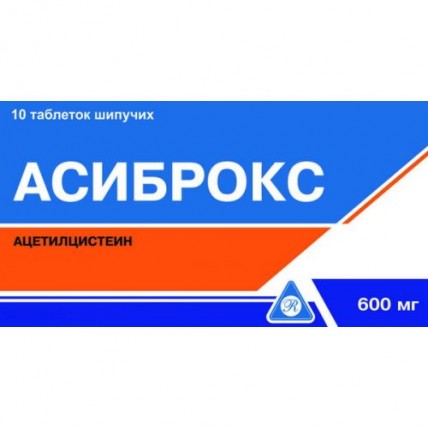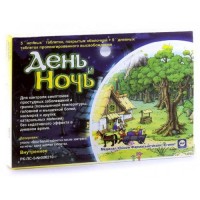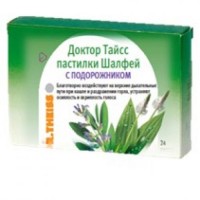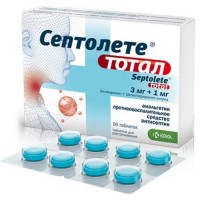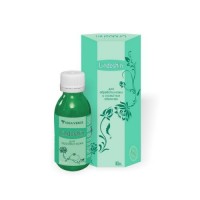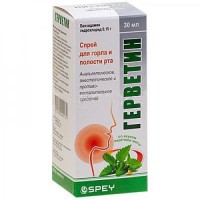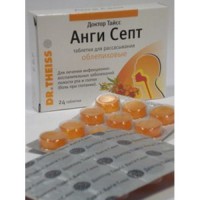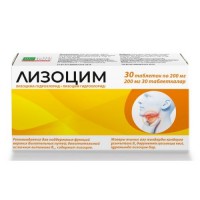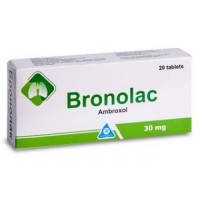Asibroks 10s 600 mg effervescent tablets
- $10.50
Sku:
747f76f1c573
Ingredient:
Acetylcysteine
The instruction for medical use
of ASIBROKS medicine
the Trade name
of Asibroks
the International unlicensed
name Acetylcysteinum Dosage Form
of the Tablet sparkling 200 mg and 600 mg
Structure
One tablet contains
active agent - Acetylcysteinum of 200 mg and 600 mg,
excipients: ascorbic acid, sodium a carbonate anhydrous, Natrii hydrocarbonas, anhydrous citric acid, sorbitol, sodium citrate, a macrogoal 6000, sodium saccharin, Lemon fragrance
the Description
of the Tablet of a ploskotsilindrichesky form, white color, is allowed easy marbling, with a characteristic smell, with a facet
Pharmacotherapeutic group
Drugs for elimination of symptoms of cold and cough. Expectorant drugs. Mucolytics. Acetylcysteinum.
The ATX R05CB01 code
the Pharmacological
Pharmacokinetics Later properties of intake Acetylcysteinum quickly and almost is completely absorbed in a digestive tract. The bioavailability of Acetylcysteinum after intake is about 10%. The maximum concentration after intake is reached in 1 - 3 hour.
In a liver it is metabolized to cysteine (pharmacological an active metabolite) and a diatsetiltsistina, cystine and further - to the mixed disulfides. In an organism Acetylcysteinum and its metabolites are defined in various forms: partially - in the form of free substance, partially - in connection with blood plasma proteins, partially - as the incorporated amino acids. It is excreted almost completely in the form of inactive metabolites (inorganic sulfates, a diatsetiltsistin) with urine. Only a small amount of Acetylcysteinum is removed in not changed view with a stake. Plasma elimination half-life of blood makes about 1 hour and depends on biotransformation speed in a liver. In a liver failure it can increase till 8 o'clock.
Acetylcysteinum can get through a placental barrier and collect in amniotic liquid.
A pharmacodynamics
Acetylcysteinum - mucolytic, the expectorant derivative of cysteine amino acid. Due to existence of free sulfhydryl group Acetylcysteinum breaks bisulfite links of acid mucopolysaccharides of a phlegm that leads to a depolymerization of mukoproteid and promotes reduction of viscosity of a bronchial secret. Facilitates otkhozhdeny phlegms due to increase in mukotsiliarny clearance. Acetylcysteinum also has antioxidant and pneumotyre-tread properties that is caused by ability of sulfhydryl groups to connect free radicals. Besides, Acetylcysteinum promotes increase in synthesis of glutathione which is an important factor of a detoxication. This feature of Acetylcysteinum gives the chance to apply it as antidote in acute poisonings with paracetamol and other substances (aldehydes, phenols, etc.).
The indications
of the Disease of respiratory organs which are followed by the increased formation of the viscous hardly separated phlegm:
- acute and chronic bronchitis
- obstructive bronchitis
- laryngotracheitis
- pneumonia
- bronchiectasias
- bronchial asthma
- bronchiolites
- a mucoviscidosis
- for simplification of an otkhozhdeniye of a secret in acute and chronic sinusitis
accepts the Route of administration and doses of Asibroks inside.
Dissolve one tablet containing 600 mg of Acetylcysteinum in 200 ml of drinking water of room temperature or one tablet containing 200 mg of Acetylcysteinum in 100 ml of drinking water of room temperature.
The drug should be taken after a meal. Additional intake of liquid enhances mucolytic effect of Acetylcysteinum. To accept right after dissolution, in exceptional cases it is possible to leave ready solution for 2 hours.
To adults and teenagers 14 years drug are more senior appoint 200 mg 2-3 times a day or on 600 mg of 1 times a day.
To children aged from 6 up to 14 years about 200 mg 2 times a day are recommended to accept.
To children aged from 2 up to 6 years appoint 200 mg of 1 times a day.
In a mucoviscidosis:
- to adults and teenagers 14 years drug are more senior appoint 200 mg 2-3 times a day or on 600 mg of 1 times a day
- to children 6 years are more senior it is recommended to accept on 200 mg 3 times a day
- to children aged from 2 up to 6 years – on 200 mg 2 times a day
- patients with body weight more than 30 kg can take the drug in a dose to 800 mg a day.
Duration of treatment depends on type and disease severity and has to be defined by the attending physician. Average course of treatment of 5-7 days.
Side effects
Sometimes
– nausea, vomiting, heartburn, diarrhea
– headaches, sonitus
- skin rash, an itching, a small tortoiseshell, in isolated cases – a bronchospasm (mainly at patients with hyperreactivity of bronchial tubes)
it is rare
– falling of arterial blood pressure, tachycardia
– stomatitis
- decrease in aggregation of thrombocytes
is Very rare
– development of pulmonary bleeding as manifestation of hypersensitivity reaction
of the Contraindication
- hypersensitivity to Acetylcysteinum and other components of drug
- children's age up to 2 years (for tablets with the content of Acetylcysteinum of 200 mg)
- children's age up to 14 years (for tablets with the content of Acetylcysteinum of 600 mg)
- pregnancy and the period of a lactation
- a peptic ulcer of a stomach and duodenum in an aggravation phase
- phenylketonuria
- a pneumorrhagia, pulmonary bleeding
- intolerance of a galactose, a glucose galactose sprue
Medicinal interactions
At simultaneous use of Acetylcysteinum and antibechics because of suppression of a tussive reflex can arise stagnation of slime. Therefore similar combinations should be selected with care.
Synergism of Acetylcysteinum with bronchial spasmolytics is noted.
The concomitant use of Acetylcysteinum and nitroglycerine can lead to strengthening of vasodilating action of the last.
Pharmaceutical it is incompatible with antibiotics (penicillin, cephalosporins, erythromycin, tetracycline and Amphotericinum B) and proteolytic enzymes therefore at simultaneous use
they should be accepted not earlier than in 2 hours after Acetylcysteinum intake.
At contact with metals, rubber, sulfides with a characteristic smell are formed.
Special indications
of Asibroks should be applied with care at a blood spitting, pulmonary bleeding, to patients with a gullet varicosity, diseases of adrenal glands, a liver and/or renal failure.
In bronchial asthma and obstructive bronchitis it is necessary to appoint Acetylcysteinum with care under systematic control of bronchial passability.
Asibroks sodium therefore before use of drug it is necessary to consult with the doctor contains sorbitol and saccharin.
During the work with drug it is necessary to use glasswares, to avoid contact with metals, rubber, oxygen, easily oxidized substances.
Use in pediatrics
Drug is contraindicated to children aged up to 14 years (for tablets with the content of Acetylcysteinum of 600 mg)
Pregnancy and the period of a lactation
of Adequate and well controlled researches about use of drug at pregnancy and in the period of a lactation was not carried out.
Asibroks it is contraindicated at pregnancy and in the period of a lactation.
The feature of influence of medicine on ability to run the vehicle or potentially dangerous mechanisms
of Asibroks does not affect ability of driving of the car and performance of work, the psychomotor reactions demanding high speed.
Overdose
Symptoms: diarrhea, vomiting, stomach aches, heartburn and nausea are possible.
Treatment: symptomatic therapy.
The form of release and packing
On 24 tablets (for a dosage of 200 mg) or 12 tablets (for a dosage of 600 mg) place in the polypropylene case closed by a polypropylene stopper with silica gel.
On 1 case together with the instruction for medical use in the state and Russian languages put in a box of cardboard.
On 2 tablets place in planimetric bezjyacheykovy packing from aluminum foil.
On 5 or 10 planimetric packs together with the instruction for medical use in the state and Russian languages put in a box of cardboard.
Storage conditions
In the dry, protected from light place, at a temperature not over 25 of 0C.
To store out of children's reach!
3 years
not to apply a period of storage after an expiration date!
Prescription status
Without prescription
Vitale-HD LLP Producer, Myaealuse 2/2, 12618 Tallinn, Estonia
(Vitale-XD Ltd., Maealuse 2/2, 12618 Tallinn, Estonia).
The owner of a trademark and the certificate of registration
is the ROTAFARM LIMITED company, GREAT BRITAIN
("ROTAPHARM LIMITED", GREAT BRITAIN).
The owner of the registration certificate of ROTAFARM LIMITED, GREAT BRITAIN
the Owner of a trademark and the certificate of registration is
the ROTAFARM company, GREAT BRITAIN
the Address of the organization accepting in the territory of the Republic of Kazakhstan claims from consumers on quality of products
of TROKA-S FARM LLP of RK, Almaty, Turksibsky district, Suyunbaya Ave., 222b Ph. / fax: 8 (7272) 529090
To develop
of ASIBROKS medicine
the Trade name
of Asibroks
the International unlicensed
name Acetylcysteinum Dosage Form
of the Tablet sparkling 200 mg and 600 mg
Structure
One tablet contains
active agent - Acetylcysteinum of 200 mg and 600 mg,
excipients: ascorbic acid, sodium a carbonate anhydrous, Natrii hydrocarbonas, anhydrous citric acid, sorbitol, sodium citrate, a macrogoal 6000, sodium saccharin, Lemon fragrance
the Description
of the Tablet of a ploskotsilindrichesky form, white color, is allowed easy marbling, with a characteristic smell, with a facet
Pharmacotherapeutic group
Drugs for elimination of symptoms of cold and cough. Expectorant drugs. Mucolytics. Acetylcysteinum.
The ATX R05CB01 code
the Pharmacological
Pharmacokinetics Later properties of intake Acetylcysteinum quickly and almost is completely absorbed in a digestive tract. The bioavailability of Acetylcysteinum after intake is about 10%. The maximum concentration after intake is reached in 1 - 3 hour.
In a liver it is metabolized to cysteine (pharmacological an active metabolite) and a diatsetiltsistina, cystine and further - to the mixed disulfides. In an organism Acetylcysteinum and its metabolites are defined in various forms: partially - in the form of free substance, partially - in connection with blood plasma proteins, partially - as the incorporated amino acids. It is excreted almost completely in the form of inactive metabolites (inorganic sulfates, a diatsetiltsistin) with urine. Only a small amount of Acetylcysteinum is removed in not changed view with a stake. Plasma elimination half-life of blood makes about 1 hour and depends on biotransformation speed in a liver. In a liver failure it can increase till 8 o'clock.
Acetylcysteinum can get through a placental barrier and collect in amniotic liquid.
A pharmacodynamics
Acetylcysteinum - mucolytic, the expectorant derivative of cysteine amino acid. Due to existence of free sulfhydryl group Acetylcysteinum breaks bisulfite links of acid mucopolysaccharides of a phlegm that leads to a depolymerization of mukoproteid and promotes reduction of viscosity of a bronchial secret. Facilitates otkhozhdeny phlegms due to increase in mukotsiliarny clearance. Acetylcysteinum also has antioxidant and pneumotyre-tread properties that is caused by ability of sulfhydryl groups to connect free radicals. Besides, Acetylcysteinum promotes increase in synthesis of glutathione which is an important factor of a detoxication. This feature of Acetylcysteinum gives the chance to apply it as antidote in acute poisonings with paracetamol and other substances (aldehydes, phenols, etc.).
The indications
of the Disease of respiratory organs which are followed by the increased formation of the viscous hardly separated phlegm:
- acute and chronic bronchitis
- obstructive bronchitis
- laryngotracheitis
- pneumonia
- bronchiectasias
- bronchial asthma
- bronchiolites
- a mucoviscidosis
- for simplification of an otkhozhdeniye of a secret in acute and chronic sinusitis
accepts the Route of administration and doses of Asibroks inside.
Dissolve one tablet containing 600 mg of Acetylcysteinum in 200 ml of drinking water of room temperature or one tablet containing 200 mg of Acetylcysteinum in 100 ml of drinking water of room temperature.
The drug should be taken after a meal. Additional intake of liquid enhances mucolytic effect of Acetylcysteinum. To accept right after dissolution, in exceptional cases it is possible to leave ready solution for 2 hours.
To adults and teenagers 14 years drug are more senior appoint 200 mg 2-3 times a day or on 600 mg of 1 times a day.
To children aged from 6 up to 14 years about 200 mg 2 times a day are recommended to accept.
To children aged from 2 up to 6 years appoint 200 mg of 1 times a day.
In a mucoviscidosis:
- to adults and teenagers 14 years drug are more senior appoint 200 mg 2-3 times a day or on 600 mg of 1 times a day
- to children 6 years are more senior it is recommended to accept on 200 mg 3 times a day
- to children aged from 2 up to 6 years – on 200 mg 2 times a day
- patients with body weight more than 30 kg can take the drug in a dose to 800 mg a day.
Duration of treatment depends on type and disease severity and has to be defined by the attending physician. Average course of treatment of 5-7 days.
Side effects
Sometimes
– nausea, vomiting, heartburn, diarrhea
– headaches, sonitus
- skin rash, an itching, a small tortoiseshell, in isolated cases – a bronchospasm (mainly at patients with hyperreactivity of bronchial tubes)
it is rare
– falling of arterial blood pressure, tachycardia
– stomatitis
- decrease in aggregation of thrombocytes
is Very rare
– development of pulmonary bleeding as manifestation of hypersensitivity reaction
of the Contraindication
- hypersensitivity to Acetylcysteinum and other components of drug
- children's age up to 2 years (for tablets with the content of Acetylcysteinum of 200 mg)
- children's age up to 14 years (for tablets with the content of Acetylcysteinum of 600 mg)
- pregnancy and the period of a lactation
- a peptic ulcer of a stomach and duodenum in an aggravation phase
- phenylketonuria
- a pneumorrhagia, pulmonary bleeding
- intolerance of a galactose, a glucose galactose sprue
Medicinal interactions
At simultaneous use of Acetylcysteinum and antibechics because of suppression of a tussive reflex can arise stagnation of slime. Therefore similar combinations should be selected with care.
Synergism of Acetylcysteinum with bronchial spasmolytics is noted.
The concomitant use of Acetylcysteinum and nitroglycerine can lead to strengthening of vasodilating action of the last.
Pharmaceutical it is incompatible with antibiotics (penicillin, cephalosporins, erythromycin, tetracycline and Amphotericinum B) and proteolytic enzymes therefore at simultaneous use
they should be accepted not earlier than in 2 hours after Acetylcysteinum intake.
At contact with metals, rubber, sulfides with a characteristic smell are formed.
Special indications
of Asibroks should be applied with care at a blood spitting, pulmonary bleeding, to patients with a gullet varicosity, diseases of adrenal glands, a liver and/or renal failure.
In bronchial asthma and obstructive bronchitis it is necessary to appoint Acetylcysteinum with care under systematic control of bronchial passability.
Asibroks sodium therefore before use of drug it is necessary to consult with the doctor contains sorbitol and saccharin.
During the work with drug it is necessary to use glasswares, to avoid contact with metals, rubber, oxygen, easily oxidized substances.
Use in pediatrics
Drug is contraindicated to children aged up to 14 years (for tablets with the content of Acetylcysteinum of 600 mg)
Pregnancy and the period of a lactation
of Adequate and well controlled researches about use of drug at pregnancy and in the period of a lactation was not carried out.
Asibroks it is contraindicated at pregnancy and in the period of a lactation.
The feature of influence of medicine on ability to run the vehicle or potentially dangerous mechanisms
of Asibroks does not affect ability of driving of the car and performance of work, the psychomotor reactions demanding high speed.
Overdose
Symptoms: diarrhea, vomiting, stomach aches, heartburn and nausea are possible.
Treatment: symptomatic therapy.
The form of release and packing
On 24 tablets (for a dosage of 200 mg) or 12 tablets (for a dosage of 600 mg) place in the polypropylene case closed by a polypropylene stopper with silica gel.
On 1 case together with the instruction for medical use in the state and Russian languages put in a box of cardboard.
On 2 tablets place in planimetric bezjyacheykovy packing from aluminum foil.
On 5 or 10 planimetric packs together with the instruction for medical use in the state and Russian languages put in a box of cardboard.
Storage conditions
In the dry, protected from light place, at a temperature not over 25 of 0C.
To store out of children's reach!
3 years
not to apply a period of storage after an expiration date!
Prescription status
Without prescription
Vitale-HD LLP Producer, Myaealuse 2/2, 12618 Tallinn, Estonia
(Vitale-XD Ltd., Maealuse 2/2, 12618 Tallinn, Estonia).
The owner of a trademark and the certificate of registration
is the ROTAFARM LIMITED company, GREAT BRITAIN
("ROTAPHARM LIMITED", GREAT BRITAIN).
The owner of the registration certificate of ROTAFARM LIMITED, GREAT BRITAIN
the Owner of a trademark and the certificate of registration is
the ROTAFARM company, GREAT BRITAIN
the Address of the organization accepting in the territory of the Republic of Kazakhstan claims from consumers on quality of products
of TROKA-S FARM LLP of RK, Almaty, Turksibsky district, Suyunbaya Ave., 222b Ph. / fax: 8 (7272) 529090
To develop
